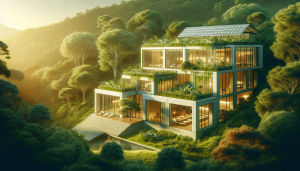In our rapidly progressing world, urban areas are buzzing hubs of innovation and development, making the pursuit of sustainable architecture both vital and complex. In this article, we delve into the key obstacles that stand in the way of integrating eco-friendly building practices in our bustling cities. From financial constraints and regulatory hurdles to the lack of awareness and technological limitations, we explore the barriers that architects and city planners face as they strive to create greener, more sustainable urban landscapes. Together, let’s uncover the intricate dynamics and potential solutions that could pave the way for a more sustainable future in our urban environments. Have you ever wondered why implementing sustainable architecture in our urban areas seems so challenging? As we become increasingly aware of the environmental impact of our cities, the need for sustainable architecture has never been more pressing. Yet, despite the clear benefits, we often face significant hurdles in bringing these eco-friendly designs to life.
Understanding Sustainable Architecture
What Is Sustainable Architecture?
Sustainable architecture is an approach to design that seeks to minimize the negative environmental impact of buildings. This involves using materials, energy, and design strategies that are environmentally friendly and resource-efficient throughout a building’s life cycle.
Why Is It Important?
Embracing sustainable architecture isn’t just a trend; it’s a necessity. Our urban areas are expanding rapidly, and if we don’t build responsibly, we’ll face severe environmental challenges. Sustainable architecture helps us conserve resources, reduce pollution, and enhance the quality of life for urban residents.
The Core Challenges in Sustainable Architecture
Economic Constraints
High Initial Costs
One of the most significant hurdles we face in implementing sustainable architecture is the high initial cost. Green technologies and materials can be expensive, and the financial burden can deter developers.
| Traditional Materials | Sustainable Materials |
|---|---|
| Typically cheaper upfront | Often costly upfront |
Limited Incentives
Without sufficient incentives, builders and developers may not see the benefit in investing in sustainable designs. Creating financial motivations through subsidies, tax breaks, and grants could help alleviate this issue.
Technological Limitations
Limited Availability of Green Technologies
While there are numerous green technologies available, they are not always accessible or well-known. This lack of availability and awareness can hinder our ability to implement sustainable architecture on a broad scale.
Rapid Technological Changes
The fast pace of technological innovation can also present a challenge. Technologies that are cutting-edge today may become outdated quickly, resulting in a reluctance to invest in current sustainable solutions for fear they’ll soon be obsolete.
Social and Cultural Barriers
Resistance to Change
People are often resistant to change, and sustainable architecture requires a significant shift in how we think about and approach building design. Overcoming this resistance involves education and a collective willingness to adopt new practices.
Lack of Awareness
Another social barrier is the general lack of awareness about sustainable architecture. Many residents and builders simply don’t understand the benefits and necessity of integrating sustainable principles into urban design.
Regulatory and Policy Issues
Inconsistent Policies
Urban areas often suffer from inconsistent policies and regulations regarding sustainable building practices. This inconsistency can create confusion and hinder the implementation process.
Lengthy Approvals
Obtaining the necessary permits and approvals for sustainable construction can be a long and complicated process. Streamlining these procedures is critical to encouraging more sustainable building projects.
Legacy Urban Infrastructure
Retrofitting Existing Buildings
Many urban areas are filled with older buildings that were not designed with sustainability in mind. Retrofitting these structures to meet modern sustainable standards can be expensive and complex.
Infrastructure Compatibility
Aligning sustainable architecture with existing urban infrastructure presents another significant hurdle. For example, integrating new green technologies within established power grids or transportation networks can be challenging.
Strategies for Overcoming These Challenges
Financial Solutions
Incentives and Subsidies
Creating robust financial incentives can help bridge the gap between high upfront costs and long-term benefits. Governments and organizations can offer subsidies, grants, and tax breaks to encourage the adoption of sustainable practices.
Low-Interest Loans
Providing low-interest loans for sustainable projects can also make these investments more attractive to developers. These loans can help offset the initial financial burden, making it easier for developers to commit to green designs.
Technological Innovation
Research and Development
Investing in research and development is crucial to advancing sustainable building technologies. Continued innovation can lower costs and increase the availability of green materials and systems.
Technology Sharing
Promoting collaboration and information sharing between countries and companies can accelerate the adoption of sustainable technologies. Open-sourcing technological advancements can make them more accessible to a broader audience.
Cultural Shifts
Education and Awareness Campaigns
Increasing public knowledge about the benefits and importance of sustainable architecture is essential. Education campaigns can help change perceptions and build support for green building initiatives.
Community Engagement
Involving the community in sustainable projects can foster a sense of ownership and acceptance. Urban residents are more likely to support eco-friendly developments if they feel they are a part of the process.
Policy Reforms
Standardized Regulations
Creating standardized regulations for sustainable building practices can reduce confusion and streamline the approval process. Uniform policies help ensure that all urban areas are working towards the same environmental goals.
Expedited Permitting
Simplifying and speeding up the permitting process for sustainable projects can also encourage more developers to embrace eco-friendly designs. Quick and efficient permit approvals can make sustainable building more attractive and feasible.
Infrastructure Upgrades
Sustainable Retrofitting Programs
Implementing programs specifically designed to retrofit existing buildings for sustainability can address the challenges of our legacy urban infrastructure. These programs can offer financial support and technical guidance to make older structures more eco-friendly.
Integrated Urban Planning
Adopting an integrated approach to urban planning that considers sustainability from the outset can help align new builds and infrastructure upgrades with green goals. This approach ensures that all aspects of urban development work together to support sustainability.
Case Studies of Sustainable Architecture in Urban Areas
Freiburg, Germany
Overview
Freiburg is often cited as one of the greenest cities in Europe. The city has implemented various sustainable initiatives, including energy-efficient buildings, extensive public transportation networks, and green spaces.
Success Factors
Freiburg’s success can be attributed to strong political will, community involvement, and comprehensive urban planning. The city’s commitment to sustainability is evident in every aspect of its development.
Portland, USA
Overview
Portland, Oregon, has also made significant strides in sustainable urban development. The city is known for its eco-friendly buildings, robust biking infrastructure, and progressive policies.
Success Factors
Portland’s achievements in sustainability are due to a combination of forward-thinking policies, financial incentives, and active community engagement. The city’s leaders have prioritized sustainability, making it a central focus of their urban planning initiatives.
Singapore
Overview
Singapore is a leading example of sustainable architecture in an urban context. The city-state has incorporated green buildings, eco-friendly transportation, and extensive green spaces into its densely populated landscape.
Success Factors
Singapore’s approach to sustainability is based on innovation, strategic planning, and strong governmental support. The city-state’s commitment to being a “City in a Garden” has driven its efforts to integrate nature into urban living.
Future Outlook
Emerging Trends
Smart Cities
The rise of smart cities, which use technology to improve urban living while reducing environmental impact, is a promising trend. Smart cities incorporate sustainable architecture as part of their broader strategy to create efficient, livable urban spaces.
Green Building Certifications
The increasing popularity of green building certifications, such as LEED and BREEAM, is encouraging more developers to adhere to sustainable practices. These certifications provide a framework and incentives for developers to create eco-friendly buildings.
Long-Term Goals
Global Collaboration
As our global awareness of environmental issues grows, international collaboration will become crucial. Sharing knowledge, technologies, and best practices can help accelerate the adoption of sustainable architecture worldwide.
Comprehensive Urban Planning
Moving forward, it is essential that we adopt a holistic approach to urban planning. Sustainable architecture should not be an afterthought but an integral part of our urban development strategies.
Conclusion
Implementing sustainable architecture in urban areas is undoubtedly challenging, but the benefits far outweigh the obstacles. With concerted efforts in financial support, technological advancement, cultural shifts, policy reform, and infrastructure upgrades, we can overcome these challenges.
By sharing the successes of cities like Freiburg, Portland, and Singapore, and by keeping an eye on emerging trends and long-term goals, we can pave the way for a more sustainable and livable future for our urban communities. Let’s embrace the challenge and work together to build cities that not only meet our needs but also respect our planet.




